
Technology has driven down the price of laser levels, making them affordable tools for homeowners, DIYers, and handymen. Use them for everything from kitchen layout to hanging photos and setting fence or deck posts. We give you our picks for the best laser levels and tell you why everyone should have (at least) one in their toolbox.
Why Do You Need a Laser Level?
Each of the best laser levels featured in this article will make you look like a pro. As a DIYer or homeowner, you can achieve the craftsmanship of professional contractors by using these tools to ensure that everything remains square and plumb from start to finish. For professionals, using the best laser level ensures you have the features and accuracy to match the quality you need and expect from your projects.
Because you can use laser levels in various ways, they are a handy tool to have in your toolbox. Whether installing kitchen cabinets or hanging pictures, these advanced tools make the job quick and easy.
Benefits of Using Laser Levels
If you’ve ever struggled to hold a bubble level in place while bracing a post or holding up a board, you’ll appreciate the hands-free functionality offered by a good quality laser level.
You can use these laser levels to square and align building materials in a variety of projects, both indoors and out. More accurate than manual bubble levels, especially over longer distances, they are extremely easy to use.
The cost of a laser level is well worth the benefits they provide. You can choose from any of several relatively inexpensive models. Durable and portable enough to carry around with the rest of your tools, they work well as an on-site tool for carpentry, renovation, and new construction.
Best Laser Levels for Professionals and Contractors
Laser levels have come a long way in recent years. They are more compact and have stronger lasers that allow you to see the beam with the naked eye. More expensive models (often with green lasers and better accuracy) play a vital role for the professional. You can use a DIY model, but it won’t give you the resolution and performance of these jobsite-ready models.
Bosch GLL3-330CG 360-Degree Green Beam Three-Plane Laser
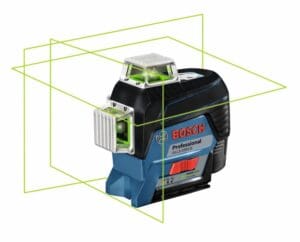
This Bosch 360-degree laser level is an excellent choice for discerning professionals looking for a high-tech laser level. It features three green beams with two vertical planes and one horizontal.
This model is accurate to ±3/32 in. at 30 ft and easy to use. With features like the Bluetooth technology smart app that pairs with your cell phone, you’ll love how much time it can save you.
The Bosch GLL3-330CG uniquely works with an included 12V battery or 4 AA batteries. That gives you some options for dealing with remote locations and lack of on-site power. You also get a hard case and heavy-duty pouch. It has an alternate manual mode and a working range of 200 feet that extends to 300 feet in pulse mode, making it the only laser level a majority of pros will ever need for interior work.
Milwaukee 3632-21 M12 Green 360° 3 Plane
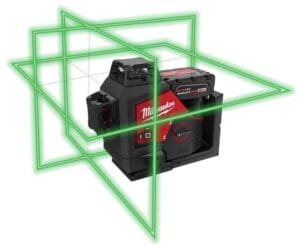
Contractors and professionals that already use Milwaukee tools should appreciate the quality and versatility of the Milwaukee 3632-21 M12 laser level kit. Pair it with an M12 RedLithium 4.0XC battery, and it offers an astounding 15 hours of run time. It also comes packed with features and accessories, including a bracket, tripod, and detector.
The bright green beam on this Milwaukee cross line laser has a working range of 125 feet. With the detector, you can increase the working distance to 165 feet. Accuracy comes to ⅛ in. at 33 feet.
This tool offers plenty of control, including features like pivot control and fine and coarse accuracy settings for fast and accurate alignment.
DeWalt DCLE34030G 20V Green Cross Line Laser

The DeWalt DCLE34030G 3 x 360 green cross-line presents an unusual form factor but a clear top choice for professionals. One of the nice things about this laser level is that you can purchase it with or without the kit, and it provides extras like a magnetic pivoting base, tripod mount, and compatibility with any DeWalt 12V or 20V battery. You even get a TSTAK-compatible case to store it all.
With a 165 feet range, the DeWalt DCLE34030G works intuitively, and the rugged overmold and IP54 rating protects your investment. It’s accurate to ⅛ in. at 30 feet, making it a solid choice for anyone in the market for a flexible premium green laser level.
Johnson 99-026K Self-Leveling Rotary Laser System
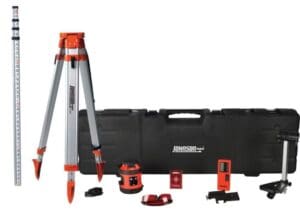
If you’re looking for the best laser leveling tool for foundations, concrete pours, and excavations, the Johnson 99-026K rotary laser system strikes us as the ideal choice. Johnson has been making a name in the leveling tool sector for over 75 years, and with this model, they’ve set the bar high.
For less money than you’d spend on some cross-line lasers, you can get this red rotary laser system with an 800 feet working diameter. It has a 6V battery charger, detector, tripod, 13-foot grade rod, numerous brackets, tinted glasses, and a hard shell carrying case.
Topcon RL-H5A Self-Leveling Horizontal Rotary Laser
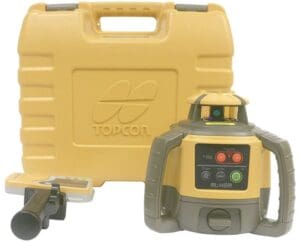
The Topcon RL-H5A Self-Leveling Horizontal Rotary Laser costs a little more than the Johnson 99-026K. However, it has a range of over 2,600 feet with 1/16 in. accuracy when using a receiver.
There are LCDs on each side. It operates at up to 600 RPM for about 120 hours on a rechargeable battery, with a convenient low-battery alert and a 30-minute automatic shutoff.
With manual and self-leveling modes and 100 hours of battery life, you’re looking at a high-end laser level built for multiple purposes. If that doesn’t convince you, the 5-year warranty should be enough to make you pull the trigger on the TopCon RL-H5A. Different package options exist, but all include a hard carrying case and receiver bracket.
Best Laser Levels for DIYers and Homeowners
Dropping prices have made the more affordable laser levels a perfect match for DIYers. These tools provide an affordable way to get projects done more easily and accurately. On top of that, they last for a very long time and give you a method of finding plumb and level on your indoor and outdoor projects without having to grab an extra hand or hold a traditional level in place. Some measuring and layout tasks are nearly impossible to do alone without these handy tools.
Skil LL9322G-01 360° Green Cross Line Laser

Try to beat the price of the 100-foot Skil LL9322G-01 green cross line laser level. We find it the best self-leveling laser for the price and you can’t beat the value for the features you get. It has all you really need in a 360-degree laser for basic layout. You get a high-visibility green laser, self-leveling, a rechargeable battery, and even a handy carrying case.
The Skil L9322G-01 also comes with a tripod, which is great for accurate laser readings. The integrated battery charges via a micro-USB port—even while operating. That makes the 6 hours of runtime a mere suggestion. We’ve even run it off a USB battery backup.
Huepar 904DG 4×360 Green Beam
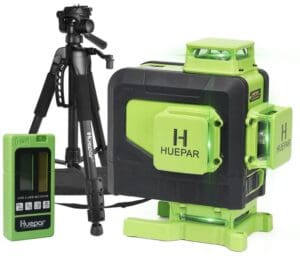
If you are okay with purchasing a lesser-known brand, the Huepar 904DG 4×360 Green Beam laser level is a good choice. It’s a professional-grade laser level at less than half the price of other top brands. It also provides FOUR laser lines for tiling or other applications.
The IP54-rated Huepar 904DG laser level operates in self-leveling and manual mode. A light blinks in manual mode to let you know when it’s not self-leveling or beyond its range (plus or minus 4 degrees).
The working range is about 150 feet, and with a detector, it increases to almost 200 feet. You can also use it on pulse mode to extend the working range. Accuracy is 1/8 in at 32 feet. The 5200 mAh battery delivers between 6 and 12 hours of runtime—enough for most applications. You can also use a power bank or car charger to power the USB charge port on the jobsite.
Ryobi Air Grip

The Ryobi Air Grip compact laser level is a great choice if you’re looking for the best budget laser level. It’s an economical laser level that costs less than $40.
The AirGrip is a unconventional battery-powered laser level. It uses a small suction pump to attach itself to walls. It also comes with an adaptor disc for attaching it to porous surfaces like stucco and concrete. The tool works up to 20 ft. with 1/8 in. accuracy.
The Ryobi Air Grip takes 2 AA batteries and should get you through several projects before having to replace the cells. Although the laser beam technically reaches as far as 30 feet, Ryobi clearly designed this measuring tool for home use. Use it to hang pictures or give it to your favorite DIYer. It might make the best Christmas tool gift ever.
How to Use a Laser Level Effectively
Once you learn how to use a laser level correctly, you can tackle just about any project more efficiently. Start with preparing your work area to ensure you don’t bump a tripod or block the laser from your position. You can also get the most out of your tool by ensuring you understand the features and how long it runs off a charge or set of batteries.
Preparing the Work Area and Laser Level
When it comes to projects like suspended ceilings, tile work, and placing electrical outlets, using a laser level does wonders for simplifying the workflow. But first, you need to prepare your work area and set up your equipment.
Clearing the Workspace and Ensuring Proper Lighting Conditions
Clear the workspace of obstructions so the laser beam can project onto surfaces. Reducing the ambient lighting as much as possible also helps you see laser beams more clearly. It also helps to wear polarized sunglasses when using these layout tools outside. As mentioned above, also decide on the placement of any tripods to maximize effectiveness and keep the tool away from potential collisions.

Calibration and Setup
Laser levels don’t normally go out of calibration unless dropped or knocked around. Still, you need to ensure they continue providing accurate readings before starting your project.
Depending on the model, you can secure the laser level in several ways. They can be secured with magnets, clips, and ceiling mounts. Some models can be attached to a universal camera tripod with a tripod attachment point.
Different Applications of Laser Levels
Laser levels are primarily used for horizontal leveling, vertical alignment, and determining slopes.
Horizontal Leveling and Aligning
Horizontal leveling creates straight lines and level surfaces in construction and landscaping for projects like tile work and installing windows.
Vertical Alignment and Plumb Lines
Vertical alignment is used to create accurate plumb lines and 90-degree angles for projects like framing and wall construction, setting posts, and installing chimneys.
Angled Alignments and Slopes
Angled alignments are used to measure the slope, useful when grading a landscape, excavation, or building retaining walls.
Tips and Best Practices for Achieving Accurate Results
Once you start using a laser level, you’ll reach for it whenever you need a quick and accurate leveling measurement. Use these tips and best practices to maximize the use of your new tool.
Checking and Adjusting Laser Level Readings
Always check and adjust laser readings before starting a new construction project. If your project isn’t level to start, it will never be level.
Most laser levels are accurate when calibrated, but inexpensive models have limitations and may drift more than 1/4-inch when measuring more than 20 to 30 feet. When hanging a picture, it’s not a big deal to be a little off, but you need more accuracy when doing precise work like setting tiles and posts.
Properly Securing and Stabilizing the Laser Level
Laser levels aren’t difficult to use, but they need to be properly secured and stabilized to provide accurate readings. Some include magnets, which can be used on metal studs or corner beads, making it easy to set up and adjust them at any height. Others affix to ceiling tile grids or hang from 2x4s.
If your tool has a tripod attachment point, find an inexpensive (but stable) camera tripod that adjusts up and down easily for quick alignment.
Frequently Asked Questions About Laser Levels
Q1: Can laser levels be used outdoors?
Laser levels are made for indoor and outdoor use, but they can be difficult or impossible to see outdoors. Green lasers help with visibility, but typically a digital target or detector lets you get accurate measurements by registering the laser even if your eyes cannot.

Q2: How far can laser levels project a beam?
The distance that a laser level can project a visible beam depends on the quality of the laser and whether you use a detector or electronic target. Indoors, line and rotary laser levels project—on average—a much stronger beam. You can often get away without a detector and still see the laser beam on an opposing wall or surface. Using a target, receiver, or detector helps increase the visibility of the beam in some models from 50 feet to over 165 feet. Many inexpensive line laser levels only remain visible to 20 or 30 feet.
Q3: Can laser levels be used for vertical alignment?
Laser levels work on horizontal and vertical planes, so they can be used for vertical alignment and ensuring your project is level horizontally. However, there are many types of laser levels, and some can perform more sophisticated functions than others. This includes purposely allowing for a small slope or locking the beam to a specific angle.
Q4: Do laser levels require frequent calibration?
The more professional and critical application, the more you need to worry about laser level calibration. For building projects and surveying, a laser needs regular certification and maintenance to retain accuracy.
You also want to ensure a laser remains accurate from the beginning of a project to the end. If you drop it or knock it over during a job, you may want to ensure it still remains within the limits of accuracy to avoid any major issues down the road. We recommend always starting major construction projects with a reliable or even freshly-calibrated level. Then, calibrate your tool on its recommended schedule or every six months.
Q5: Are laser levels safe to use?
It’s important to take precautions when using a laser level because the light can cause serious damage to your eye, even though it only uses a small amount of power. Lasers can damage your eyes in the time it takes to blink so be sure never to let the beam cross paths with your eyes.






